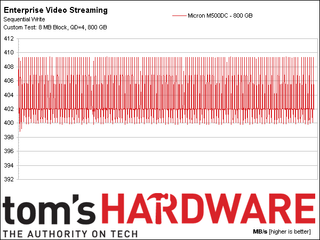Micron M500DC 800 GB SSD Review: Cloud And Web 2.0 Storage
Building on the desktop-oriented M500, Micron is announcing its enterprise-focused M500DC. We got a chance to run the 800 GB model through an updated test suite to gauge whether this Marvell-powered SSD keeps up with the best-known enterprise solutions.
Results: Enterprise Video Streaming Performance
Video streaming is a demanding workload within the enterprise space. Companies want more HD streams with higher bit-rates and no stuttering. A storage solution well-suited for enterprise-class video delivery has completely different capabilities than something designed for databases. At the end of the day, you're basically looking for exceptional large-block sequential write performance. You also need a high level of consistency that traditionally isn't seen from consumer SSDs. For a more in-depth analysis, take a look at page 10 of Intel SSD 910 Review: PCI Express-Based Enterprise Storage.

As we saw in our sequential testing, the M500DC does not post a very high sequential write rate. But what it lacks in throughput is more than made up for by consistency.
The graph above is highly averaged, with each point representing 800 MB, but the consistency is still evident. In fact, the range from peak to trough is roughly +/- 1% of the average. We run this test 100 times on each drive, and every cycle looks exactly like the chart we're showing you.
Due to limits of Excel, I can't chart out the individual 8 MB writes, but I assure you that they're incredibly consistent. In fact, in order to maintain 400 MB/s (which is 25 MB/s higher than Micron's spec), we only need a 32 MB buffer. That is outstanding.
Stay On the Cutting Edge: Get the Tom's Hardware Newsletter
Join the experts who read Tom's Hardware for the inside track on enthusiast PC tech news — and have for over 25 years. We'll send breaking news and in-depth reviews of CPUs, GPUs, AI, maker hardware and more straight to your inbox.
Current page: Results: Enterprise Video Streaming Performance
Prev Page Results: Sequential Performance Next Page New: Power Consumption, Detailed-
ParrLeyne Good article/review!Reply
Only one _small_ problem. According to the Micron product page (http://www.micron.com/products/solid-state-storage/enterprise-sata-ssd/m500dc-enterprise-sata-ssd) the M500DC is a SATA device, not SAS! -
tripleX The author obviously does not understand the subject matter. SAS lumped in with SATA? read-centric SSD isnt meant for read workloads? etc. numerous errors, too many to list.Reply -
tripleX Author does not understand what "corner case" is. corner case testing? are you doing lab validation work?Reply -
drewriley In SSD testing, it is common to call the mix in testing between read/write and random/sequential as '4 corner' or 'corner case' testing. And yes, this is lab verification work, that is kind of the point of the review. Also, SAS and SATA do compete for applications. The point was to put different product that had similar specifications against one another.Reply -
tripleX Reply13279486 said:In SSD testing, it is common to call the mix in testing between read/write and random/sequential as '4 corner' or 'corner case' testing. And yes, this is lab verification work, that is kind of the point of the review. Also, SAS and SATA do compete for applications. The point was to put different product that had similar specifications against one another.
The fact you are claiming this is anything even remotely near lab validation exposes your tremendous lack of knowledge on the subject.
No one refers to 4-corner testing as corner case testing. One link to a reputable site that does so? Instead of arguing an indefensible point you should be attempting to learn exactly what corner case means. Most would have had the good sense to do that before posting.
SAS v SATA is like Formula 1 compared to Go-Karts. Another example of your lack of understanding. SAS is meant for users who require certain features, and the price demands that users are aware of those features. They do not compete against each other, they are two entirely different classes of hardware.
-
tripleX The fact you are claiming this is anything even remotely near lab validation exposes your tremendous lack of knowledge on the subject.Reply
No one refers to 4-corner testing as corner case testing. One link to a reputable site that does so? Instead of arguing an indefensible point you should be attempting to learn exactly what corner case means. Most would have had the good sense to do that before posting.
SAS v SATA is like Formula 1 compared to Go-Karts. Another example of your lack of understanding. SAS is meant for users who require certain features, and the price demands that users are aware of those features. They do not compete against each other, they are two entirely different classes of hardware.
Most Popular



